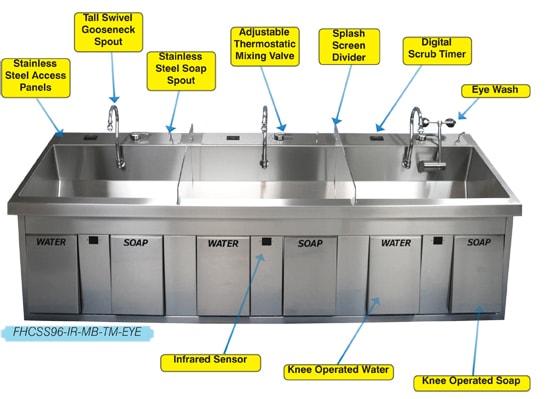
Hands are your tools for healing, but if they’re not washed properly, they can also be a transmitter for infection. Surgical site infections greatly contribute to nosocomial infections. Most surgical professionals agree on the importance of good surgical hand-washing practices in infection prevention. Hand transmission is a critical factor in the spread of bacteria, pathogens, viruses, and nosocomial infections in general.
There are two methods of scrubbing in. One is a numbered stroke method, in which a certain number of brush strokes are designated for each finger, palm, back of hand, and arm.
The alternative method is the timed scrub, and each scrub should last from three to five minutes, depending on facility protocol.
According to Infection Control Today, the procedure for the timed five-minute scrub consists of:
- Removing all jewelry (rings, watches, bracelets).
- Washing hands and arms with antimicrobial soap and hot water. Excessively hot water is harder on the skin, dries the skin, and is too uncomfortable to wash with for the recommended amount of time. However, because cold water prevents soap from lathering properly, soil and germs may not be washed away.
- Cleaning subungual areas with a nail file.
- Start timing. Scrub each side of each finger, between the fingers, and the back and front of the hand for two minutes.
- Proceed to scrub the arms, keeping the hand higher than the arm at all times. This prevents bacteria-laden soap and water from contaminating the hand.
- Wash each side of the arm to three inches above the elbow for one minute.
- Repeat the process on the other hand and arm, keeping hands above elbows at all times. If the hand touches anything except the brush at any time, the scrub must be lengthened by one minute for the area that has been contaminated.
- Rinse hands and arms by passing them through the water in one direction only, from fingertips to elbow. Do not move the arm back and forth through the water.
- Proceed to the operating room suite holding hands above elbows.
- If the hands and arms are grossly soiled, the scrub time should be lengthened. However, vigorous scrubbing that causes the skin to become abraded should be avoided.
- At all times during the scrub procedure care should be taken not to splash water onto surgical attire.
- Once in the operating room suite, hands and arms should be dried using a sterile towel and aseptic technique.
Stainless Steel Scrub Sinks
Unlike most materials, stainless steel doesn’t form cracks or tears and thus avoids storing dirt and bacteria. With today’s demanding conditions in a medical environment, doctors and surgeons need to ensure that their facility provides the most reliable material on the market within their budget. The construction of stainless steel not only provides sanitation, but also durability and resistance to corrosion and scratches.
Although stainless steel is extremely sterile, it also requires routine cleaning and a bright polished surface finish for maximum corrosion resistance. Most facilities also benefit from stainless steel because it can be cleaned with just soap and water and does not require harsh chemicals.
Manufactured of the highest quality possible, Future Health Concepts delivers a full line of hands-free, fully functional surgical scrub sinks that are also budget-friendly. Whether you need a single, double or even triple scrub sink, FHC can provide it all.